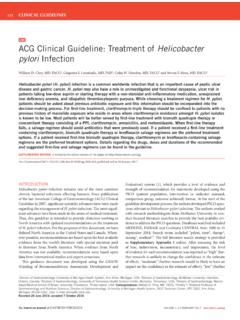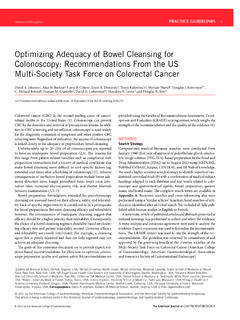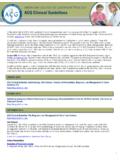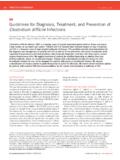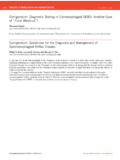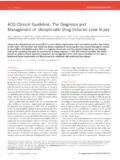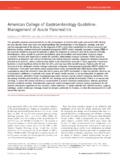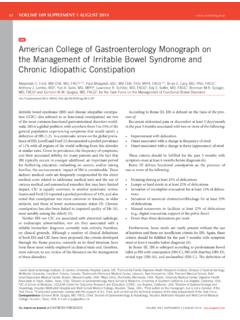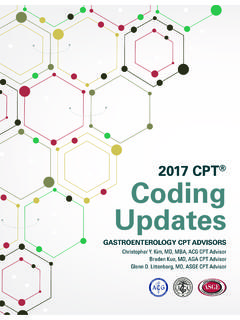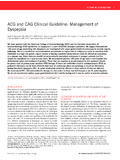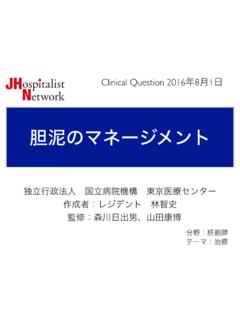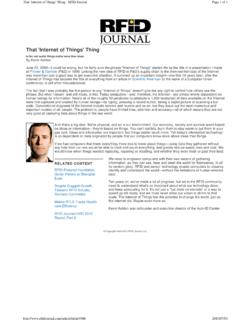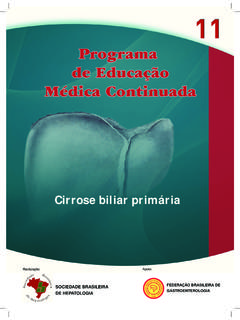Transcription of ACG Clinical Guideline: Primary Sclerosing Cholangitis
1 646 PRACTICE GUIDELINES nature publishing group CMErelated editorial on page x see ACG Clinical Guideline: Primary Sclerosing Cholangitis Keith D. Lindor, MD, FACG1, 2, Kris V. Kowdley, MD, FACG3 and M. Edwyn Harrison, MD2. Primary Sclerosing Cholangitis is a chronic cholestatic liver disease that can shorten life and may require liver transplantation. The cause is unknown, although it is commonly associated with colitis. There is no approved or proven therapy, although ursodeoxycholic acid is used by many on an empiric basis. Complications including portal hypertension, fat-soluble vitamin de ciency, metabolic bone diseases, and development of cancers of the bile duct or colon can occur. Am J Gastroenterol 2015; 110:646 659; ; published online 14 April 2015. PREAMBLE be reviewed at an established time and indicated at publication, The writing group was invited by the Practice Parameters Com- to assure continued validity.
2 Mittee and the Board of the Trustees of the American College of Gastroenterology to develop a practice guideline on Primary scle- rosing Cholangitis (PSC). INTRODUCTION. Guidelines for Clinical practice are intended to indicate Primary Sclerosing Cholangitis (PSC) is a chronic cholestatic liver preferred approaches to medical problems as established by and biliary tract disease that has a highly variable natural history scientifically valid research. Double-blind, placebo-controlled (1). The pathogenesis of the disorder remains elusive, although studies are preferable, but reports and expert review arti- the complications of the disease are a direct result of fibrosis and cles are also used in a thorough review of the literature con- strictures involving intra and extrahepatic bile ducts (1).
3 PSC. ducted through the National Library of Medicine's MEDLINE. may be asymptomatic for long periods but may also have an When only data that will not withstand objective scrutiny aggressive course, leading to recurrent biliary tract obstruction, are available, a recommendation is identified as a consen- recurrent episodes of Cholangitis , and may progress to end-stage sus of experts. Guidelines are applicable to all physicians who liver disease. The diagnosis is now most frequently established address the subject, without regard to specialty training or using magnetic resonance cholangiography (MRCP), although interests, and are intended to indicate the preferable but not direct cholangiography may be more sensitive (2). The typical necessarily the only acceptable approach to a specific cholangiographic findings include focal stricturing and saccular problem.
4 Guidelines are intended to be flexible and must be dis- dilatation of the bile ducts, which may lead to a beaded appear- tinguished from standards of care that are inflexible and rarely ance (3). violated. Given the wide range of specifics in any healthcare prob- The differential diagnosis of PSC includes several disorders that lem, the physician must always choose the course best suited to lead to biliary strictures such as bacterial Cholangitis , intraarterial the individual patient and the variables in existence at the moment administration of floxuridine, prior biliary surgery, and AIDS- of decision. related cholangiopathy (3). Guidelines are developed under the auspices of the American College of Gastroenterology and its Practice Parameters Com- De nition mittee, and are approved by the Board of Trustees.
5 Each has PSC is an idiopathic condition defined as the presence of bead- been intensely reviewed and revised by the Committee, other ing and stricture formation of the intra and/or extrahepatic bile experts in the field, physicians who will use them, and special- ducts that cannot be ascribed to another cause, thus differentiat- ists in the science of decision of analysis. The recommendations ing PSC from secondary Sclerosing Cholangitis (1,3 5). Many, if of each guideline are therefore considered valid at the time of not most, cases of PSC are associated with inflammatory bowel their production based on the data available. New developments disease (IBD) (1,6 8). Therefore, PSC is a diagnosis of exclusion in medical research and practice pertinent to each guideline will that can be established only in the absence of toxic, infectious, or 1.
6 College of Health Solutions, Arizona State University, Phoenix, Arizona, USA; 2 Division of Gastroenterology and Hepatology, Mayo Clinic, Phoenix, Arizona, USA;. 3. Liver Care Network and Organ Care Research, Swedish Medical Center, Seattle, Washington, USA. Correspondence: Keith D. Lindor, MD, FACG, College of Health Solutions, Arizona State University, 550 North 3rd Street, Phoenix, Arizona 85004, USA. E-mail: Received 1 October 2014; accepted 22 March 2015. The American Journal of GASTROENTEROLOGY VOLUME 110 | MAY 2015 ACG Clinical Guideline 647. inflammatory processes, which may lead to the characteristic bile 4. Antimitochondrial autoantibody testing can help exclude duct injury pattern (1). Primary biliary cirrhosis. (Conditional recommendation, moderate quality of evidence) (25).
7 Epidemiology 5. Patients with PSC should be tested at least once for elevated The prevalence and incidence of PSC varies in different series from serum immunogloblulin G4 (IgG4) levels. (Conditional different regions of the world. The prevalence of PSC in ulcera- recommendation, moderate quality of evidence) (26 28). tive colitis has been estimated to be ~5%. A survey in Sweden of 1,500 patients with ulcerative colitis found that 5% had an elevated The diagnosis of PSC is generally made in the setting of chronic alkaline phosphatase (ALP); the diagnosis of PSC was confirmed cholestatic liver test abnormalities, in particular elevations of serum in 55 patients, a prevalence of (9). PSC was also more com- ALP level, along with cholangiograpic evidence of multifocal stric- mon in men and those with pancolitis compared with those with tures of the intrahepatic and extrahepatic bile ducts, which may left-sided colitis or proctitis ( vs.)
8 A recent study found involve the intrahepatic or extrahepatic duct, or both (3). A liver that approximately two-thirds of a cohort of 579 patients had IBD, biopsy, if performed, will show changes consistent will PSC (29). three-quarters had ulcerative colitis, and the majority had pan- The characteristic onion skin fibrosis, which is almost pathogno- colitis (6). The prevalence of IBD among Asian and Southern Euro- monic for the disease, is seen infrequently (30). Furthermore, liver pean populations with PSC is estimated to be 30% 50% (1). Based biopsy is seldom required to establish the diagnosis (21). on these data, the prevalence of PSC in the United States has been estimated to be in the range of 1 to over 16 per 100,000 (1). It is pos- Signs and Symptoms sible that the true prevalence of PSC may be higher or lower than A large number of patients present without symptoms and come these estimates, because cholangiography may not be frequently to attention simply by a finding of persistently abnormal liver tests.
9 Performed, may fail to identify all cases, and as many patients with When symptoms occur, fatigue maybe the most commonly noted PSC may have normal serum ALP. finding but it is nonspecific. Sudden onset of pruritus should signal Gender: Approximately 60% 70% of patients with PSC and UC the possibility of obstruction of the biliary tree. Other symptoms are men, and age at diagnosis is usually 30 40 years (1). Among are those of advanced liver disease such as jaundice or gastro- patients without UC, there is a slight female predominance. intestinal bleeding. Many patients with PSC may have IBD; hence, bleeding from the colon should lead to consideration of IBD as well Pathogenesis as bleeding from portal hypertension. Abdominal distention with The cause of PSC remains elusive, although there have been fluid and confusion are late symptoms, as is jaundice.
10 Some patients several large-scale genome-wide association studies that have may have fever and pain arising from Cholangitis and other patients identified genotypic associations in cohorts with PSC (1,10 12). experience chronic right upper quadrant discomfort; however, Similarly, characteristic human leukocyte antigen haplotype right upper quadrant pain is not a prominent feature of PSC. associations have long been recognized in PSC (1,13,14). In addition, the strong association between PSC and IBD points to Biochemical Tests a possible role of autoimmunity (1). Other putative causes for Blood tests usually show a cholestatic profile with predominate PSC have been suggested, such as mutations in the gene encoding elevation of ALP level. Gamma-glutamyl transferase will be ele- the cystic fibrosis transmembrane receptor and recurrent bacte- vated if obtained and the aminotransferases are often times only rial infections (1,15 18).
